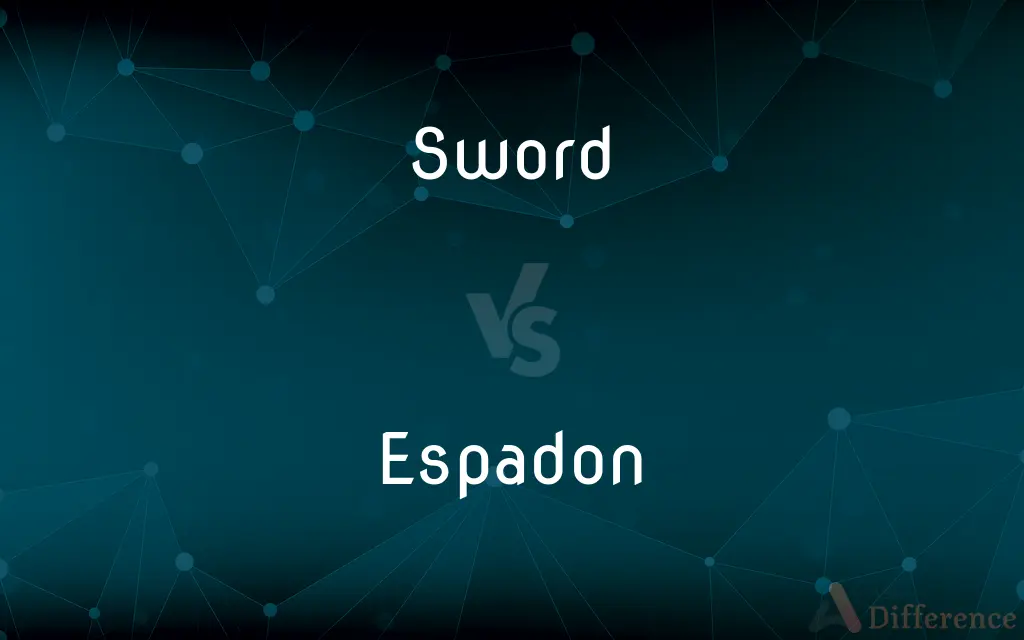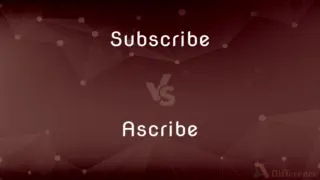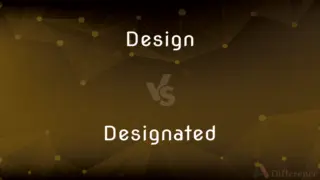Sword vs. Espadon — What's the Difference?
By Maham Liaqat & Fiza Rafique — Updated on April 26, 2024
Swords are typically shorter, versatile weapons used across various cultures, while an espadon, a specific type of sword, is a large two-handed European sword known for its length and cutting capability.

Difference Between Sword and Espadon
Table of Contents
ADVERTISEMENT
Key Differences
Swords come in various shapes and sizes, designed for both cutting and thrusting, depending on the culture and historical period. Whereas the espadon is a type of sword that specifically refers to a large, two-handed sword used primarily in Europe during the Renaissance period.
The general term "sword" can refer to anything from a short Roman gladius to a slender, sharp rapier. On the other hand, the espadon is characterized by its considerable length, often exceeding four feet, which made it ideal for delivering powerful cuts from a distance.
Swords have been used throughout history not only as weapons but also as symbols of power and authority. In contrast, the espadon was particularly favored for its effectiveness in battle, especially in open combat where its reach and cutting power could be fully utilized.
The adaptability of swords is notable, with designs evolving to meet the specific needs of various fighting styles and combat situations. Whereas the espadon remained relatively specialized, its design largely unchanged, emphasizing its role as a heavy cutting weapon.
While swords are universally recognized and have a prominent place in folklore and mythology across the world, the espadon is less widely known outside of historical European martial arts circles and is often overshadowed by more famous swords like the longsword or the claymore.
ADVERTISEMENT
Comparison Chart
Length
Varies widely, generally under 4 feet
Typically over 4 feet
Usage
Cutting, thrusting, ceremonial
Primarily cutting, used in battle
Cultural Significance
Widespread, symbolic across many cultures
Primarily European, less symbolic
Design Variety
Extremely diverse, many types and forms
More uniform, large two-handed design
Historical Period
From ancient times to modern day
Primarily Renaissance Europe
Compare with Definitions
Sword
A tool used historically for both combat and ceremonial purposes.
The museum displayed swords from the medieval period.
Espadon
Not widely recognized outside of specific historical or martial arts contexts.
Unlike the broadsword, the espadon is not commonly featured in popular media.
Sword
A symbol of authority and justice.
In many cultures, a sword represents the power of life and death.
Espadon
Associated with specific European martial traditions.
The espadon techniques were detailed in several historical fencing manuals.
Sword
An implement in various sports and arts, like fencing.
He won the championship with his precision in handling the fencing sword.
Espadon
Known for its length, often surpassing four feet.
His espadon was nearly as tall as he was, making it a formidable weapon.
Sword
Figuratively, anything that resembles a sword in function or shape.
The surgeon's scalpel is the sword with which they fight disease.
Espadon
Less common in modern contexts, primarily studied by enthusiasts of historical weapons.
He practiced with an espadon at the historical martial arts club.
Sword
A weapon with a long metal blade and a hilt with a handguard.
The knight unsheathed his sword before the duel.
Espadon
A large, two-handed European sword used historically for cutting.
The espadon was favored by foot soldiers in the Renaissance for its reach.
Sword
A sword is an edged, bladed weapon intended for manual cutting or thrusting. Its blade, longer than a knife or dagger, is attached to a hilt and can be straight or curved.
Espadon
(historical) A long, heavy, two-handed and two-edged sword, formerly used by Spanish foot soldiers and by executioners.
Sword
A handheld weapon consisting typically of a long, straight or slightly curved, pointed blade having one or two cutting edges and set into a hilt.
Espadon
A long, heavy, two-handed and two-edged sword, formerly used by Spanish foot soldiers and by executioners.
Sword
The use of force, as in war.
Sword
Military power or jurisdiction.
Sword
(weaponry) A long-bladed weapon device with a grip- a hilt (a pommel and cross guard), which is designed to cut, stab, slash and/or hack.
Sword
(tarot) A suit in the minor arcana in tarot.
Sword
(tarot) A card of this suit.
Sword
(weaving) One of the end bars by which the lay of a hand loom is suspended.
Sword
(heraldry) The weapon, often used as a heraldic charge.
Sword
To stab or cut with a sword
Sword
An offensive weapon, having a long and usually sharp-pointed blade with a cutting edge or edges. It is the general term, including the small sword, rapier, saber, scimiter, and many other varieties.
Sword
Hence, the emblem of judicial vengeance or punishment, or of authority and power.
He [the ruler] beareth not the sword in vain.
She quits the balance, and resigns the sword.
Sword
Destruction by the sword, or in battle; war; dissension.
I came not to send peace, but a sword.
Sword
The military power of a country.
He hath no more authority over the sword than over the law.
Sword
One of the end bars by which the lay of a hand loom is suspended.
Sword
A cutting or thrusting weapon with a long blade
Common Curiosities
Can a sword be used for purposes other than fighting?
Yes, swords can also serve ceremonial roles and as symbols of authority.
What is the primary use of a sword?
Swords are primarily used for combat, including cutting and thrusting, and as ceremonial objects.
Were swords used in all parts of the world?
Yes, versions of swords were used across various cultures around the world.
What materials are swords typically made from?
Swords are typically made from metals like steel or iron.
What makes the espadon different from other European swords?
The espadon is distinct due to its large size and specialization in cutting.
What types of swords are there?
There are many types, including rapiers, longswords, and katana, each suited to different fighting styles.
What historical period does the espadon belong to?
The espadon was most prominent during the Renaissance period in Europe.
How long is an espadon typically?
An espadon is typically over four feet in length.
Is the espadon still used today?
The espadon is primarily of interest to historical weapon enthusiasts and is not used in modern combat.
Do swords appear in mythology?
Yes, swords feature prominently in many myths and legends, symbolizing power and heroism.
Is the espadon considered a practical weapon today?
No, the espadon is considered impractical for modern uses and is mainly a historical curiosity.
What is the cultural significance of the espadon?
The espadon has specific cultural significance in European history but lacks the broader symbolic impact of swords in general.
Are there sports that involve swords?
Yes, fencing is a sport that uses swords like the foil, epee, and sabre.
How effective was the espadon in battle?
The espadon was highly effective in battle due to its reach and cutting ability.
How did the design of swords evolve over time?
Sword designs evolved to adapt to changing combat conditions and technologies.
Share Your Discovery

Previous Comparison
Subscribe vs. Ascribe
Next Comparison
Design vs. DesignatedAuthor Spotlight
Written by
Maham LiaqatCo-written by
Fiza RafiqueFiza Rafique is a skilled content writer at AskDifference.com, where she meticulously refines and enhances written pieces. Drawing from her vast editorial expertise, Fiza ensures clarity, accuracy, and precision in every article. Passionate about language, she continually seeks to elevate the quality of content for readers worldwide.
















































